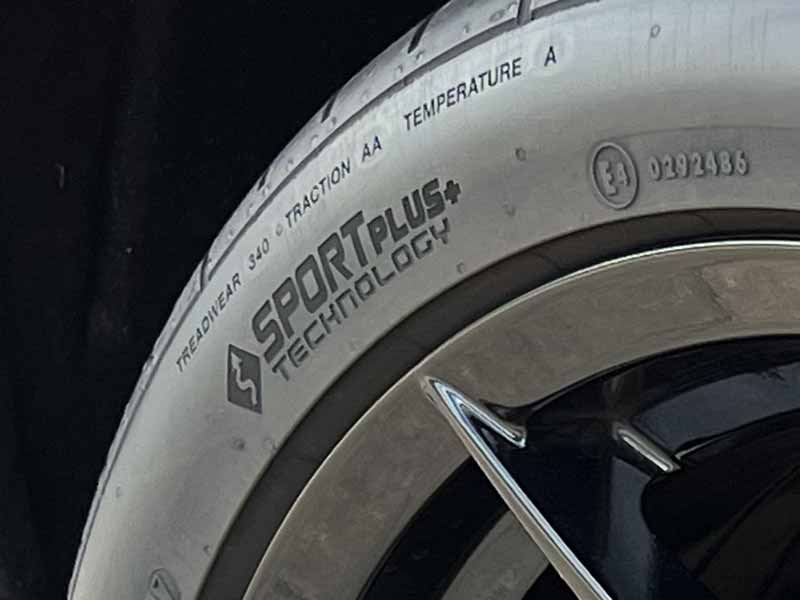You might be wondering why the temperature portion of the UTQG tire ratings is important. It turns out that these ratings can affect everything from how well your vehicle grips the road to its fuel efficiency.
What Is A Good Tire Temperature Rating?
Most tires sold today meet the Uniform Tire Quality Grade (UTQG) “A” temperature rating, and there are few reasons to accept a lower rating.
“B” temperature tires are acceptable for daily driving but should be avoided unless you can save a substantial amount of money considering the wide availability of “A” tires.
In this article, we’ll cover the ins and outs of tire temperature ratings, compare different rating categories, and discuss other crucial factors you should consider when selecting the perfect tires for your vehicle.
Let’s take a closer look.

What Does Temperature Rating Mean On Tires?
Tire temperature ratings are like a report card for your tires, but instead of grading how well they perform in school, they show how well your tires handle heat. Heat is a big deal for tires because it can affect their overall performance and safety. When you drive, tires generate heat, and the temperature rating tells you how good a tire is at resisting heat and staying cool.
Purpose Of Tire Temperature Rating
Why should you care about tire temperature ratings? Well, when your tires get too hot, they can lose their grip on the road, making it harder for you to control your car. In extreme cases, hot tires can even suffer from tread separation, which can be super dangerous. The temperature rating helps you pick the right tires for your car that can handle the heat and keep you safe on the road.
How Temperature Ratings Are Determined
Tire temperature ratings are determined through a series of tests by tire manufacturers and organizations like the U.S. Department of Transportation. These tests check how well a tire can handle heat when it’s being driven at high speeds, carrying heavy loads, or driving in hot weather. They also test the tire’s ability to cool down after being heated up.
Temperature Rating Vs Performance
So, how does the tire temperature rating connect with how well a tire performs? A higher temperature rating generally means the tire can handle heat better and has a lower chance of overheating. This can be important if you drive a lot at high speeds, live in a hot climate, or regularly carry heavy loads. In these situations, having tires with a good temperature rating will help ensure your car’s performance stays on point and you stay safe on the road.
Tire Temperature Rating Chart
Tire temperature ratings are divided into three categories: A, B, and C. Just like in school, an “A” is the best rating, while a “C” is the lowest. Here’s a quick breakdown of what each rating means:
- A: Excellent heat resistance and performance
- B: Good heat resistance and performance
- C: Moderate heat resistance and performance

Tire Temperature Rating A
An “A” rating means that the tire can handle heat like a champ. It’s able to resist high temperatures and stay cool, even when driving fast or carrying heavy loads. If you’re looking for top-notch performance and safety, A-rated tires are the way to go.
Tire Temperature Rating B
“B” rated tires are still pretty good at managing heat, but they’re not quite as awesome as A-rated tires. They can handle most driving situations, but they might not be the best choice if you’re constantly driving in very hot weather or at super high speeds.
Tire Temperature Rating C
“C” rated tires have the lowest heat resistance, which means they’re more likely to get hot and lose their grip on the road. While they’re okay for everyday driving, they might not be the best choice if you need a tire that can handle extreme conditions.

Factors That Affect Tire Temperature Ratings
There are several factors that can impact a tire’s temperature rating, including:
- The materials used to make the tire: Some materials are better at handling heat than others.
- The tire’s construction: The way a tire is built can affect how well it manages heat.
- The tire’s tread design: Certain tread patterns can help keep a tire cool and improve its temperature rating.
Tire Temperature Examples
Now, let’s take a look at some examples of tire types and their temperature ratings:
- Performance tires: These tires are designed for high-speed driving and usually have an A or B temperature rating. They’re made from materials that can handle heat well and have tread patterns that help keep them cool.
- All-season tires: These tires are made for year-round use and can handle a variety of weather conditions. They usually have a B or C temperature rating, which means they’re good for most everyday driving situations.
- Economy tires: These tires are designed to be budget-friendly and often have a C temperature rating. They might not have the best heat resistance, but they’re usually fine for casual driving. Just be aware that they might not be the best choice if you’re looking for top-notch performance or need a tire that can handle extreme conditions.

Tire Temperature Rating A Vs B
When it comes to heat resistance and performance, A-rated tires take the lead. They’re designed to handle high temperatures better than B-rated tires, which means they’re more likely to keep their grip on the road and stay cool even during high-speed driving or in hot weather. B-rated tires, on the other hand, offer good heat resistance, but they might not perform quite as well as A-rated tires under extreme conditions.
When To Choose A-Rated Tires Over B
You should consider choosing A-rated tires if:
- You live in a hot climate where temperatures often soar.
- You frequently drive at high speeds, like on highways or racetracks.
- You want the best possible heat resistance and performance for your tires.
- You often carry heavy loads or tow trailers.
In these situations, A-rated tires can provide better performance and safety than B-rated tires, thanks to their superior heat resistance.
When To Choose B-Rated Tires Over A
B-rated tires can be a good choice if:
- You live in an area with moderate temperatures most of the time.
- Your driving habits include a mix of city and highway driving.
- You’re looking for a balance between performance and cost.
- Extreme heat resistance isn’t a top priority for you.
B-rated tires still offer good heat resistance, and they’re usually more budget-friendly than A-rated tires, making them a solid choice for many drivers.
Impact On Fuel Efficiency And Tread Life
A-rated tires tend to have better heat resistance, which can help improve fuel efficiency and extend tread life. When tires stay cooler, they’re less likely to wear down quickly or suffer from heat-related damage. B-rated tires can still offer decent fuel efficiency and tread life, but they might not perform as well as A-rated tires in these areas, especially if you drive in extreme conditions or at high speeds often.

Tire Temperature Rating B Vs C
B-rated tires have better heat resistance and performance compared to C-rated tires. While both can handle everyday driving, B-rated tires are better equipped to handle high temperatures, which means they’re more likely to maintain their grip on the road and stay cool during hot weather or high-speed driving. C-rated tires, on the other hand, have the lowest heat resistance, making them more prone to overheating and losing grip under extreme conditions.
When To Choose B-Rated Tires Over C
You should consider choosing B-rated tires if:
- You live in an area with moderate temperatures most of the time.
- Your driving habits include a mix of city and highway driving.
- You’re looking for a balance between performance and cost.
- You don’t often drive in extreme heat or at very high speeds.
In these situations, B-rated tires can offer a good combination of performance, safety, and affordability.
When To Choose C-Rated Tires Over B
C-rated tires can be a suitable choice if:
- You mostly drive at low speeds, like in urban areas or residential neighborhoods.
- You live in a region with mild temperatures year-round.
- You’re on a tight budget and need the most affordable tire option.
While C-rated tires aren’t the best at handling heat, they can still perform adequately for casual, everyday driving.
Impact On Fuel Efficiency And Tread Life
B-rated tires generally have better heat resistance than C-rated tires, which can lead to improved fuel efficiency and longer tread life. When tires can effectively resist heat, they’re less likely to wear down quickly or suffer from heat-related damage. C-rated tires, with their lower heat resistance, might not provide the same level of fuel efficiency or tread life, especially if you frequently drive in high temperatures or at high speeds.

Additional Factors To Consider When Choosing Tires
Before diving into the specific factors you should consider when choosing tires, it’s crucial to remember that a tire’s temperature rating is just one piece of the puzzle. While temperature ratings are essential in helping you pick a tire that can handle heat, there are other factors that come into play when selecting the right tires for your vehicle and driving needs.
It’s always a good idea to take a holistic approach and consider several aspects of a tire to ensure you’re making the best decision for your safety, performance, and overall satisfaction. Now, let’s explore some of these additional factors.
Speed Rating
Apart from temperature ratings, it’s important to consider a tire’s speed rating, which tells you the maximum speed at which a tire can safely carry a load. Speed ratings are represented by letters, like “S,” “T,” “H,” or “V.” Make sure to choose a tire with a speed rating that matches or exceeds the needs of your vehicle and driving habits.
Load Capacity
Load capacity is another key factor when selecting tires. It tells you how much weight a tire can safely support. Each tire has a load index number, which corresponds to a specific weight capacity. Always choose tires with a load index that meets or exceeds your vehicle’s requirements, especially if you regularly carry heavy loads or tow trailers.
Weather Conditions And Tire Type
Think about the weather conditions you typically encounter when driving. If you live in a region with snowy winters, you might want to consider winter tires that have a better grip on icy roads. On the other hand, if you live in an area with mostly warm temperatures, summer tires could be a better fit. All-season tires offer a balance between performance and adaptability for drivers who experience a variety of weather conditions throughout the year.
Personal Driving Habits And Preferences
Lastly, consider your personal driving habits and preferences when choosing tires. If you enjoy a sporty, high-performance driving experience, you might want to opt for performance tires with a high temperature and speed rating. On the other hand, if comfort and fuel efficiency are your top priorities, you might prefer touring tires with a lower temperature and speed rating. Remember, it’s essential to select tires that match your needs and provide a safe, enjoyable driving experience.
Resources
Below are some links you may find helpful when learning about tires
Final Thoughts
The seemingly simple letter grades of A, B, and C can have a significant impact on a tire’s performance, safety, and heat resistance.
“Tires are the only part of your vehicle that actually touches the road.” With that in mind, let’s remember to view tire selection as a comprehensive process, considering not just temperature ratings but also the many other factors that contribute to the overall performance and safety of your tires.
Good luck and happy motoring.




